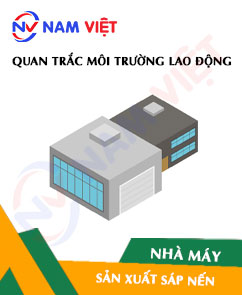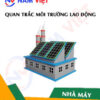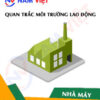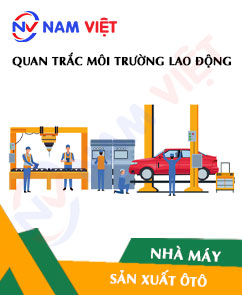Occupational environment monitoring at the factory producing candles
99,000 ₫
Note: The above price is calculated for one sample. Prices may fluctuate depending on the area of the environment to be monitored and market conditions. For more accurate pricing support, please refer to the price list or contact our consulting staff directly.
Workplace environment monitoring for a candle production factory is a session of collecting, analyzing, and evaluating factors at the workplace that may be harmful to workers health.
Table of Contents
Toggle1. Overview of Candle Manufacturing Factories
a. What is a candle manufacturing factory?
A factory for candle manufacturing is a production facility specializing in producing candles, which are used to provide light and fragrance when burned. This factory typically has specific processes and equipment to produce candles from natural wax or synthetic wax.
The exact production processes and types of machinery used in a candle manufacturing factory may vary depending on the scale and technology of each specific factory.

b. Production stages in a candle manufacturing factory
Production stages in a candle manufacturing factory may include:
- Raw material preparation: Natural wax (such as beeswax) or synthetic wax is prepared and measured according to required ratios.
- Wax melting: Wax is heated in thermal systems to melt into liquid form.
- Adding color and fragrance: During melting, coloring agents and essential oils may be added to create desired colors and scents for the candles.
- Mold and casting material preparation: Molds and casting materials (usually metal) are prepared to shape the candles.
- Pouring wax into molds: Wax is poured into molds or desired shapes using machinery or manually.
- Inserting wicks: A wick is inserted into the top of the candle to create a flame point.
- Cooling and solidifying: Candles are cooled and solidified in molds or desired shapes.
- Quality inspection: Solidified candles are checked to ensure there are no defects or product flaws.
- Cutting, wicking, and finishing: Solidified candles are cut to size, wicks are added, and decoration, packaging, and labeling are completed.

c. Machinery used in candle manufacturing factories
In candle manufacturing factories, the following machinery may be used:
- Wax melting machine: Used to melt wax into liquid form for casting.
- Wax pouring machine: Used to pour wax into molds or desired shapes. Can be automatic or semi-automatic.
- Wick inserting machine: Used to insert the wick into the top of the candle.
- Candle wick cutting machine: Cuts the wick to the appropriate length for candles.
- Cooling and solidifying machine: Used to cool and solidify wax after pouring into molds.
- Candle cutting machine: Used to cut solidified candles into desired sizes and shapes.
- Decoration and finishing machine: Used for decorating candles, adding color, patterns, or printing on the wax surface.
- Packing and labeling machine: Used to package candles and attach product labels.

d. Occupational diseases for workers in candle manufacturing factories
Workers in candle manufacturing factories may be exposed to certain occupational diseases common in this work environment. Some typical occupational hazards include:
- Respiratory diseases: Exposure to dust, fumes, or wax vapor may cause irritation, pneumonia, rhinitis, coughing, difficulty breathing, bronchitis, sinusitis, or allergic rhinitis.
- Skin diseases: Contact with wax, chemicals, and oils can cause skin irritation, dermatitis, eczema, cracking, infection, and other skin issues.
- Organ-related effects: Candle-related work may impact eyes (conjunctivitis, eye irritation), ears (ear inflammation), nervous system (headache, dizziness), digestive system (digestive disorders), and central nervous system (chemical exposure effects).
- Work-related stress or strain: Repetitive motion, heavy lifting, or awkward working postures may cause muscle pain, strain, and musculoskeletal issues.
To ensure safety and protect worker health in candle manufacturing factories, personal protective measures, safety management, and workplace environmental controls must be applied. This includes good ventilation, use of personal protective equipment (masks, goggles, gloves), safety and health training, and compliance with occupational safety regulations and procedures.

e. Common types of candles on the market
There are many popular types of candles on the market, differing in composition, color, fragrance, and use. Some common types include:
- Paraffin wax: The most common type, made from paraffin oil. White and translucent, usually odorless, producing a stable flame.
- Soy wax: Made from soybean oil, plant-based, eco-friendly, light yellow, and retains fragrance well.
- Cinnamon wax: Combination of paraffin wax and cinnamon essential oil, dark brown, with characteristic cinnamon fragrance.
- Palm wax: Made from palm oil, usually yellow or light yellow, heat-resistant, with a stable flame and good fragrance retention.
- Peanut or legume wax: Made from peanut or soybean oil, light yellow, used in handmade candles.
- Natural wax: Includes beeswax, candelilla wax, or carnauba wax, preferred for natural origin and fragrance retention.
2. Overview of Workplace Environmental Monitoring Services
a. What is workplace environmental monitoring at candle manufacturing factories?
Workplace environmental monitoring (or occupational environment assessment) at candle manufacturing factories involves collecting, evaluating, and analyzing workplace environmental factors. This helps implement timely measures, minimize environmental hazards for workers’ health, and prevent occupational diseases. Environmental monitoring is mandatory for candle manufacturing factories.
Monitoring is crucial for protecting and enhancing workers’ health because workers are the main resource directly contributing to company profits. Frequent exposure to hazardous factors above allowed limits may negatively affect health and cause occupational diseases.
REGISTER FOR WORKPLACE ENVIRONMENT MONITORING SERVICE
b. An Toan Nam Viet’s workplace environmental monitoring program
An Toan Nam Viet’s program is designed by monitoring engineers specializing in occupational safety and environmental protection. Using modern measurement methods, it monitors air quality, water quality, microclimate factors, physical conditions, and dust in the workplace. The program ensures a safe working environment and protects workers’ health.
It also plays a key role in researching and developing solutions to improve workplace environmental quality. With the dedication and professionalism of its experts, An Toan Nam Viet’s exclusive program is a breakthrough in occupational safety and environmental management in Vietnam.

c. Standardization in workplace environmental measurement procedures
Standardization in An Toan Nam Viet’s procedures ensures measurement accuracy and reliability. The program uses recognized standards from the Ho Chi Minh City Department of Health. Data collected is highly reliable for evaluating workplace environments and making decisions to protect workers.
Standardized procedures are carried out by highly qualified monitoring experts, ensuring managers can trust results from An Toan Nam Viet.
By applying standardization, An Toan Nam Viet demonstrates its commitment to safe workplaces, protecting workers’ health, and contributing to occupational safety and environmental management in Vietnam.
d. Reporting results of monitoring at candle manufacturing factories
Results are prepared according to Form No. 04, Appendix III issued with Decree 44/2016/ND-CP, with 2 copies: one for the contracting factory, one retained by the monitoring organization.
Records are stored indefinitely, as required by law.

e. Frequency of workplace environmental monitoring according to law
According to Clause 2, Article 18 of the Law on Occupational Safety and Hygiene 84/2015/QH13, employers must organize environmental monitoring at least once a year.
f. Deadline for submitting monitoring reports according to law
Deadline is before December 31 each year. Factories must submit reports to the local Department of Health. If there are changes in technology or upgrades creating new hazards, the factory must update occupational hygiene records and perform monitoring.
g. Penalties for violations in workplace environmental monitoring
According to Article 27, Decree No. 12/2022/ND-CP:
- Clause 2: Fine of VND 2,000,000 – 5,000,000 for failing to publicly announce monitoring results at the workplace immediately.
- Clause 3: Fine of VND 20,000,000 – 40,000,000 for not performing workplace environmental monitoring as required.
- Clause 4: Fine of VND 40,000,000 – 60,000,000 for collaborating with monitoring organizations to commit fraud, without criminal liability.
3. Harmful environmental factors for workers in candle manufacturing factories
In the working environment of candle manufacturing factories, there are several environmental factors that can be harmful to workers. The following are some potential hazards that may affect the health of workers in the candle production industry:
- Dust and chemical fumes: The candle production process can generate dust from raw materials and chemical fumes from melting wax. These dust particles and fumes can irritate the respiratory system and eyes, cause discomfort, and pose potential health risks.
- Toxic gases: During candle production, toxic gases may be released, such as volatile organic compounds or carbon dioxide (CO2). Prolonged exposure to these gases can affect the nervous system, respiratory system, and muscles.
- Temperature and humidity: The working environment in candle manufacturing factories may have high temperatures and humidity due to the melting and molding processes. These conditions can cause discomfort and affect worker health and performance.
- Noise: The operation of machinery and equipment in candle manufacturing factories can produce high noise levels. Prolonged exposure to loud noise can harm hearing and the nervous system.
- Electrical safety: The use of electrical equipment during candle production may pose risks of fire, explosion, and injuries to workers.
REGISTER FOR OCCUPATIONAL ENVIRONMENT MONITORING SERVICE
4. Measures to improve working conditions in candle manufacturing factories
To improve working conditions in candle manufacturing factories and protect worker health, the following measures can be applied:
- Dust and chemical management: Ensure proper control and management of dust generation and handling during production. Use effective dust extraction systems to protect workers’ eyes and respiratory systems. Additionally, ensure chemicals are used safely and according to regulations, with full information provided on their effects.
- Ensure ventilation and fan systems: Improve ventilation in factories to reduce humidity and ensure fresh airflow. Use effective fan systems to create a comfortable workspace and reduce factory temperatures.
- Training and use of protective equipment: Ensure workers are trained to use personal protective equipment (PPE) such as masks, safety goggles, gloves, chemical-resistant clothing, and helmets. Maintain and regularly check the performance and quality of protective equipment.
- Noise control: Apply noise control measures in factories using soundproofing, insulation, and protective earmuffs for workers. Reduce noise from equipment and machinery through regular maintenance and soundproofing measures.
- Electrical safety: Perform regular inspections and maintenance of electrical systems in factories. Ensure safe use of electrical equipment and compliance with electrical safety regulations. Train workers on electrical safety and emergency procedures in case of incidents.
- Periodic health checks: Conduct regular health check-ups for workers to detect and address health issues potentially related to the working environment early.
- Training and education: Provide regular training and education on occupational safety, safe work procedures, and preventive measures against occupational diseases.
- Risk management and compliance: Implement risk management measures such as fire prevention plans, waste management, and compliance with safety, hygiene, and environmental protection regulations relevant to candle production.
- Periodically conduct occupational environment monitoring in factories to collect and analyze harmful factors affecting workers, then adjust and reduce hazards to prevent occupational diseases.
5. Benefits of periodic monitoring in candle manufacturing factories
An Toan Nam Viet provides businesses with significant benefits when using occupational environment monitoring services in accordance with Decree 44/2016/ND-CP on managing and controlling harmful workplace factors affecting employees.
- Businesses can proactively control harmful factors in workshops or factories.
- Receive advice and recommendations on measures to reduce harmful factors and improve workplace environment quality.
- Indirectly protect human resources, a key factor in business development.
- Reduce the harmful effects of occupational diseases on health, minimizing future treatment costs.
- Enhance worker health, ensuring product quality and maintaining production output.
- Ensure compliance with labor safety laws and avoid legal risks.
- Enhance credibility and professionalism in all aspects, elevating the company’s brand.
Nam Viet’s environmental monitoring service is a solution to reduce occupational disease risks, contributing to a clean and high-quality working environment.

6. National occupational environment monitoring center
Occupational environment monitoring center of Nam Viet is a professional unit specializing in monitoring and measuring workplace environmental quality across all provinces in Vietnam. With a team of experienced monitoring specialists, the center uses modern measurement equipment to ensure accuracy and reliability.
Besides monitoring services, the center assists clients in planning, managing, and tracking occupational environmental issues. With the motto “customer-centered,” the center prioritizes client satisfaction, meets all client needs, and commits to providing the best solutions for businesses.
REGISTER FOR OCCUPATIONAL ENVIRONMENT MONITORING SERVICE
With investments in technology, equipment, and human resources, Nam Viet’s monitoring center has become one of the most reputable units in occupational environment monitoring in Ho Chi Minh City, with the following objectives:
- We always value our brand reputation and the quality of our service products.
- We provide clients with the best and most suitable solutions possible.
- With a team of experienced Masters and Engineers, committed to environmental protection and benefiting businesses.
- By choosing Nam Viet Environmental Monitoring, companies receive professional service from experts and the best cost advantages.
The occupational environment monitoring process at Nam Viet includes the following basic steps:
- Before monitoring, we ensure all equipment is calibrated according to legal regulations.
- Follow occupational environment monitoring procedures committed to the Department of Health accurately and fully.
- Report monitoring results honestly to employers.
- If monitoring results indicate unsafe conditions, Nam Viet provides corrective solutions, and the workplace implements the following:
- Implement measures to improve working conditions, minimize harmful factor impacts, and prevent occupational diseases.
- Conduct health examinations to detect occupational and related diseases early for workers in unsafe environments.
- Provide in-kind compensation to workers according to labor law.

7. Occupational environment monitoring quotation
To help businesses conduct professional and effective occupational environment monitoring, Nam Viet provides clients with a quotation for occupational environment monitoring services that is high-quality and reasonably priced.
- Our quotation provides detailed pricing information for the monitoring services we offer, including costs related to travel, measurement, analysis, and reporting. Clients can trust the accuracy and reliability of the monitoring reports we provide.
- We commit to offering competitive and reasonable prices in the market and are always ready to provide quick and professional advice for any inquiries regarding monitoring services.
- With Nam Viet’s monitoring quotation, clients can easily select service packages suitable to their needs. We are committed to delivering the highest satisfaction with professional service quality.
No comments yet












Review Occupational environment monitoring at the factory producing candles
There are no reviews yet.